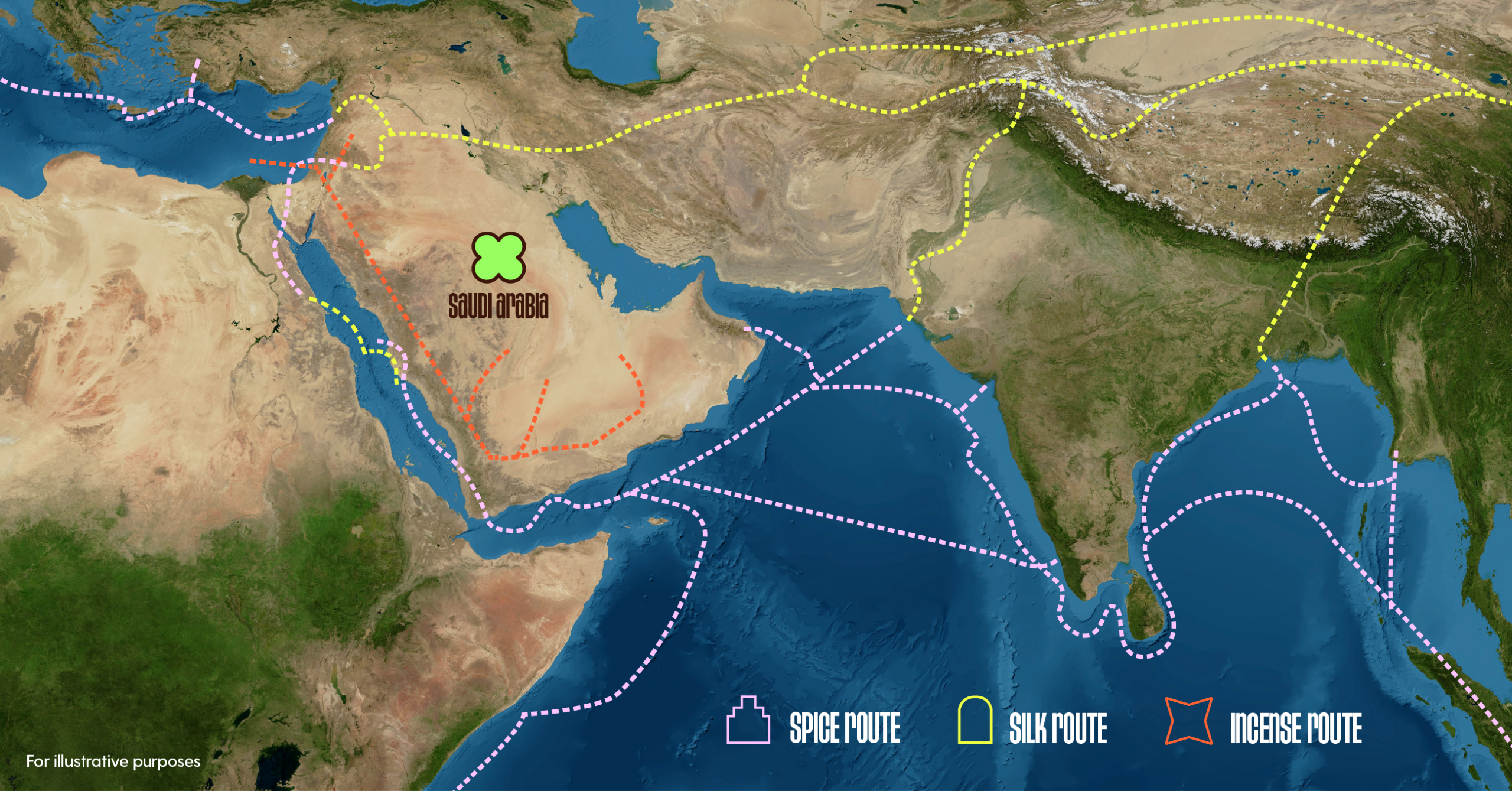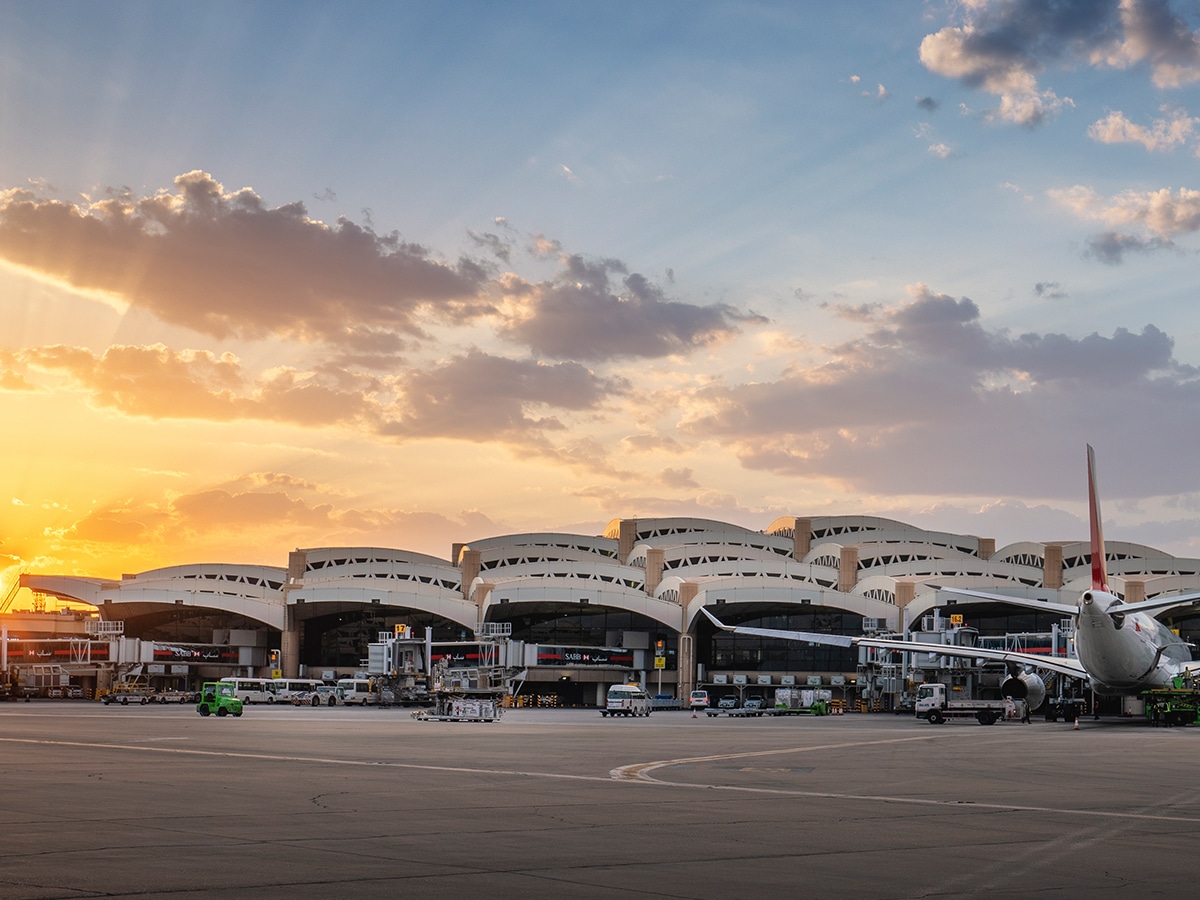From Month-Long Caravans to 60% of the World Within Hours – Saudi’s Past, Present, and Future as a Global Trading Hub
Take a look at a map. Pick out the continents of Africa, Asia, and Europe. What’s the big country that sits between all three? It’s Saudi Arabia (of course). If you’re thinking something like, ‘hey what a convenient place that must be for trade and travel,’ you’d be right because Saudi has been a global trading hub for millennia.
Hear of the silk road? Saudi was a part of it.
The incense route? Saudi again.
Spice? That too.
The latest digital tech? Are you getting it? Yes, it’s Saudi.
Join us on our own ‘question caravan’ (aka a Q&A) where we explore what has kept Saudi Arabia at the heart of global trade for millennia.
What makes Saudi a good location for a trade hub?
Saudi Arabia is literally at meeting point of Africa, Asia, and Europe – both overland and directly across the easily navigable Indian Ocean, Arabian Gulf, and Red Sea. And while Saudi’s deserts may have looked rough, their human inhabitants were (and are!) quite the opposite. Often built around oases, the Kingdom’s ancient Kingdoms welcomed traders as both eager consumers and producers of tradeable commodities. Today, the Kingdom’s land and sea connections remain and major international airports also have now put 60% of the world’s population within eight hours flight time.
When did Saudi first emerge as a trading hub?
Potentially as long ago as 3000 BCE! Part of ancient Egypt’s Red Sea trade routes, you see. But Saudi’s first real trading hub heyday began around 1000 BCE with the emergence of the Nabatean kingdoms (the same folks who left us the epic site of rock-carved Hegra (AlUla) and their desire to smell nice, persisting into the emergence of the spice trade with Asia and the silk road all the way out to China. The emergence of Islam and the Makkah pilgrimage in the 7th century CE further consolidated this status.
What made incense so important they had their own trade networks?
Fundamentally, the same reason any commodity becomes “hot” – people want it! And in the days before greenhouse agriculture and factories, a lot of commodities had to be sourced from the source.
In the case of incense, Frankincense and Myrrh, both from the sap of trees native to the Arabian peninsula and Eastern Africa, perfumes were as popular (and expensive) then as they are today.
What about spice? And silk?
What are common flavors today (cinnamon, cassia, cardamom, ginger, pepper, nutmeg, star anise, clove, turmeric etc.) were more than a supermarket trip away. They had to be imported from their native lands, including India, Sri Lanka, and Indonesia, and were so valuable that fantastic legends were coined to disguise their origins.
As for silk, ancient China had the quantity and quality to dominate the production of this luxurious and desirable garment. And, like incense and spice, it had to get from China to its buyers around the world.
[Combined trade routes map]
What were the main connections?
It’s easiest to just show you! This map shows just how far-reaching these ancient trade routes were.
And what were the main locations in Saudi for the trade?
The historic Red Sea port of Jeddah was (and is) a big one – but look at a map of Saudi and you’ll see how extensive the trade networks within the country were, with openings for whatever direction trade came from. Najran, in the south, was one of the first stops for Indian ocean sailors or overland caravans from Yemen and Oman. Head desert-ways and affluent Qaryat Al-Faw shows the name “Empty Quarter” isn’t entirely accurate as it was the capital of the ancient Kingdom of Kindah and a vital caravan stopping point. We’ve already mentioned Hegra and AlUla, home to the Nabataean master-traders, so head north from there for a time out in Tayma, another vital desert oasis city – its importance attested by the numerous artifacts from different civilizations.
Is there anything left of these sites?
Yes! All these places have incredible archaeological sites ready to explore. What’s more, the spice, incense, and silk trade is still very much alive in the souqs of Saudi Arabia where sacks of scented produce await. You can read more about them in our article here.
How did they transport spices to and around Saudi?
Arabian sailors have a long heritage – and the distinctive triangle-sailed boats they used (known as dhows) are still in use today! In ancient times, these traders earned a reputation as master-mariners, plying the ocean to India and up the Red Sea to Egypt and the Mediterranean. On land, travel was by “caravan” – not a small home on wheels, but a group of traders, guards, and their families moving together for support and protection using camels, horses, mules, and donkeys. Along their route, “caravanserai” were akin to inns, offering food, water, and resting places.
Is Saudi still a trading hub today?
Absolutely! The country has invested over US$2.5 billion in expanding its sea ports and airports. Coupled with that, more and more major international companies, including Apple, are setting up regional headquarters and distribution hubs in the country, once again drawing on that ancient Saudi heritage as the meeting point of continents and cultures.
What does the future hold?
As Saudi re-establishes itself as a global trading hub, that long-standing history of welcoming travelers, tourists, and traders to visit, live, and work in the country is becoming more and more evident again. And, just as has happened through history, this meeting of peoples is elevating quality of life for everyone – whether they live in Saudi or have the country as a stopping off point for a desirable product.


